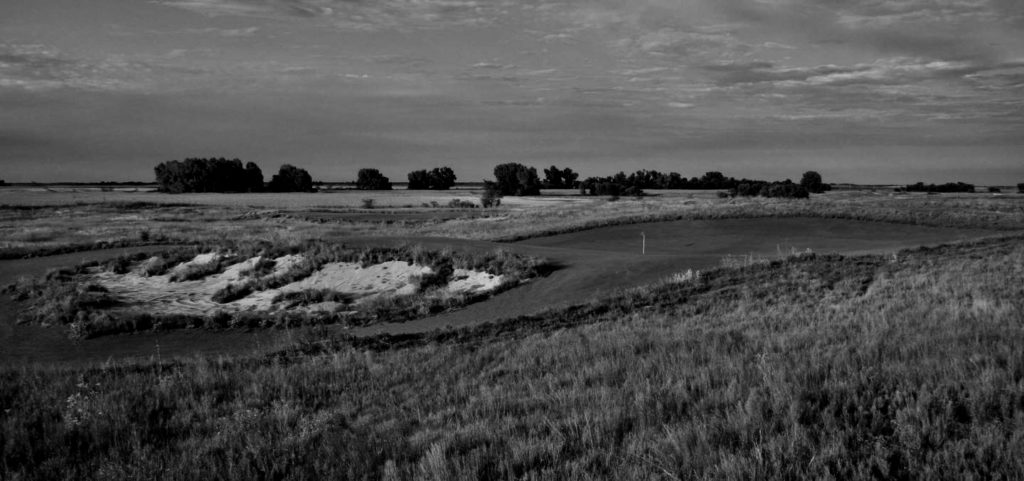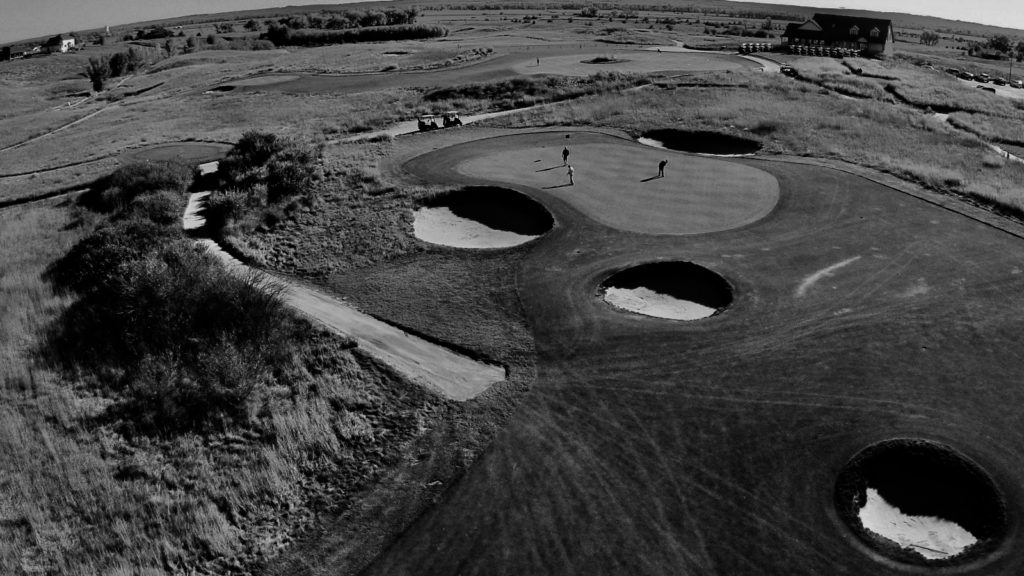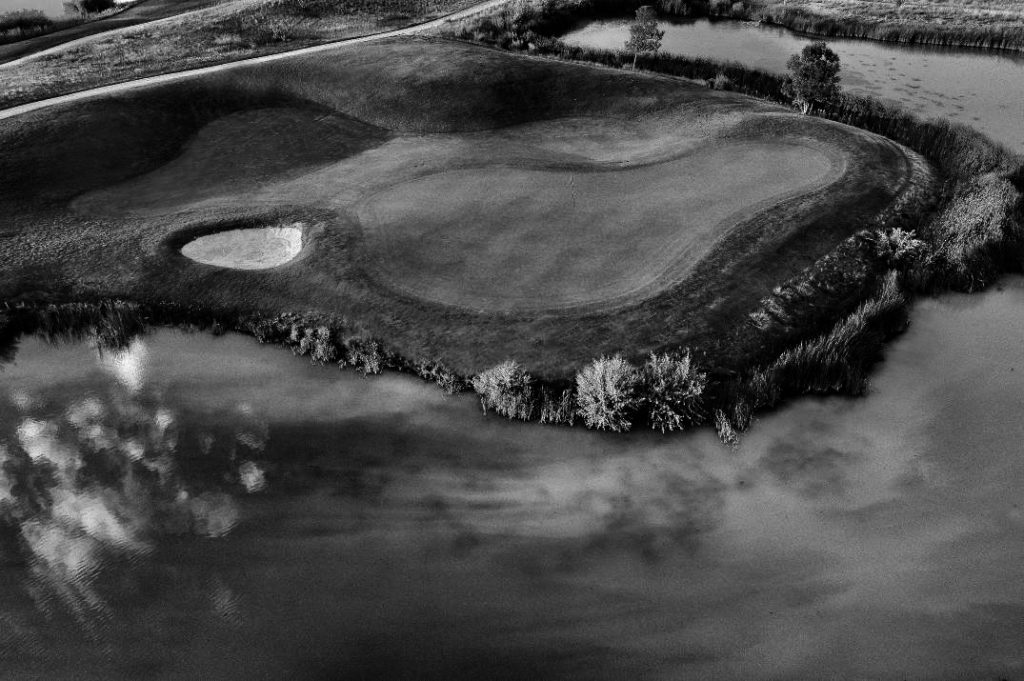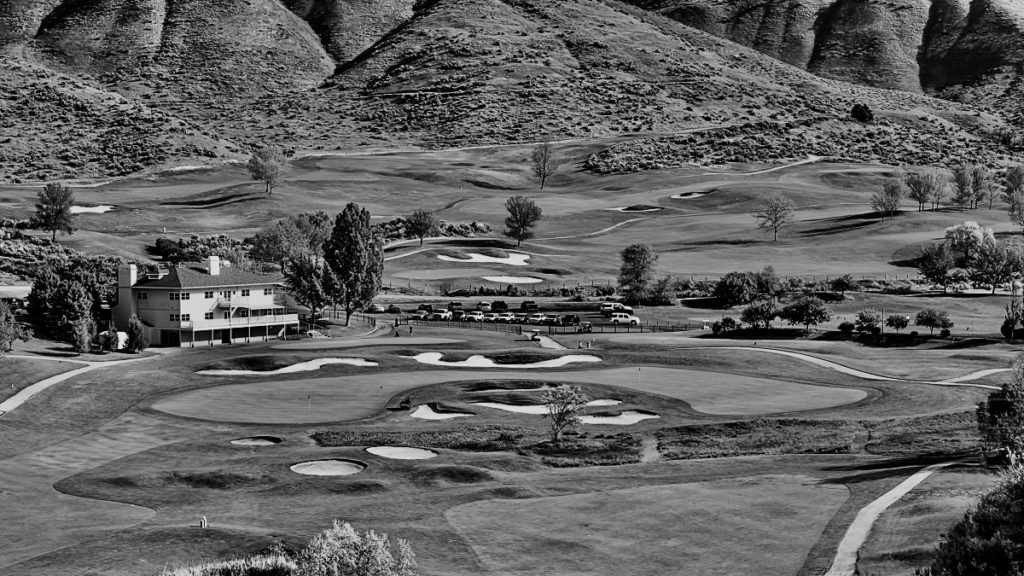Several months ago, scratching a creative itch, we set about creating The Appalachian Golf Trail, consisting only of notable golf clubs located within walking distance (less than 5 miles) from the most famous hiking trail in the United States. The results, of course, were a disaster. Of the eight clubs identified, only seven have survived until the publication of this post. One, the Hanover Country Club, has since been closed by Dartmouth College. The others are fine, to our knowledge.
That disaster being completed, and our boredom continuing, we began seeking another topic to fill some blog space. A chance encounter with a ‘90s computer brought forth the obvious solution: The Oregon Golf Trail.
There is a significant difference between this and the Appalachian Golf Trail, namely in that you can still hike the Appalachian one, and the Oregon Trail has largely been paved over. After all, using Bill Coore’s routing logic (he follows animal trails, assuming they’ve already figured out the best ways around a property), the Oregon Trail existed for a reason. It was the most passable way to get from Kansas City to Portland. Therefore concrete roads have often been built along the rivers where a dirt one once ran. The point is you can’t, safely at least, hike the Oregon Golf Trail. That said, for the fun of the exercise, we’ve left the “five mile” rule in place. The result is a collection of six public golf courses, along with a collection of privates that you can try to tap as you travel West.
Here’s a map of the Oregon Trail so you can plan your trip and follow along with this ridiculous exercise. One bit of advice: Never try to ford the river with your golf clubs.

1. Awarii Dunes Golf Course…Axtell, NE
No doubt many residents of Kansas City are immediately confused as to why none of the city’s fine golf clubs are included in this exercise. After all, the Oregon Trail began in Kansas City…why shouldn’t the Oregon Golf Trail? The answer lies in the five-mile rule we established and the unfortunate coincidence that none of the KC courses I considered lay within a five-mile radius of the trail (as recognized by the National Park Service). Many apologies to Kansas City natives. Your BBQ is among the best.
That means our first course during this journey doesn’t come until about midway through Nebraska. The term “dunes” is thrown around frequently in golf, often with no actual dunes required. Those in-the-know are familiar with Nebraska’s significant sand base, and that the state is perhaps trailing only Oregon and Wisconsin for being the trendiest place in American golf. Unfortunately this journey won’t take us by Sand Hills proper, but Awarii Dunes in Axtell is a decent alternative (and it’s public, to boot). Jim Engh is better known for making heroic courses across the mountains and deserts of the American West, but he plays well to the strength of the sandy soil base here. No. 17, with its crumpled fairway and largely blind punchbowl green, demonstrates the fun in using the dunes as both visual and strategic stimulation.

2. Wild Horse Golf Club…Gothenburg, NE
Again, no, we will not be visiting Sand Hills during this trip. Some important information on that club, however, and its famous blowout bunkers: Many associate the aesthetic with the design firm of Bill Coore and Ben Crenshaw, which is fair, but it’s important to give proper credit to Dave Axland, the pair’s most preeminent shaper across the firm’s most noted designs. Axland has been responsible for several designs under his own name, such as Old Toccoa Golf Club, which I wrote glowingly about. The first project for Axland’s Bunker Hill firm (a partnership with Dan Proctor) was Wild Horse Golf Club in Gothenburg.
Those familiar with Sand Hills will immediately spot the similarities between it and Wild Horse, even if the latter does have a less-blessed piece of property on which to build a course. Axland’s bunkering style is evident throughout, but he and Proctor use the sandy land to their advantage, even when not creating sand hazards. One of the best holes at the course, somewhat ironically, requires no bunkers at all. No. 6 follows a Tillinghast Double-Dogleg setup to challenge players with the curves of the course (and the curves of the land it sits on). Of course, if you’re here for the sand, the next hole features a nice big centerline bunker in the fairway for you to consider.
No doubt the American pioneers stopped to consider how well a golf course would fit on this land, and now that manifest destiny is complete. Also, I’m sure the Swedish pioneers stopped to think how great this area would be for a melodic death metal scene.

3. Three Crowns Golf Club…Casper, WY
And now for something completely different, and not just because we’re moving into Wyoming from Nebraska. The Oregon Trail spends a significant amount of time following major rivers, for a variety of reasons. One, rivers tend to be the lowest altitude in a region, and taking the wagons through the mountains leads to Donner Party situations. Secondly, rivers tend to flow to the sea (this is poor logic east of the Rockies, but whatever). The river that got the most love from pioneers was the North Platte. Golfers, however, don’t necessarily want to be by a river, or any water for that matter.
Three Crowns isn’t right on the Platte, but it does use a series of irrigation ponds to create uncomfortable situations for players. Eight holes feature a body of water sitting up against the green. I’m a Robert Trent Jones II defender when it comes to design, but I’ll acknowledge he can get a little Heroic School from time to time, like his brother Rees. This may be one of those times. That said, if you don’t mind picking up a cheaper set of golf balls, or have always wanted to play TPC Sawgrass on a budget, Three Crowns may be your cup of tea. The difference here is that you’ll have a nice mountainous backdrop, which you won’t find anywhere in Florida, outside of Disney World. When you’re done, head down the river to the Fort Caspar Museum to learn more about the town when (non-golfing) pioneers came through.
4. Canyon Springs Golf Course…Twin Falls, ID
I was familiar with the name Bob Baldock, as he’s been involved in a multitude of clubs and courses across the Western United States, although few have reached the name recognition as Engh’s work. The first name on the design list at Canyon Springs Golf Course, Bob Mueller, was a mystery to me. A quick GolfAdvisor search confirmed that Canyon Springs was his only credit. The name of the course and the town that hosts it, Twin Falls, demonstrates you don’t always require extensive training to create a fun course. The “Canyon” refers to the deep trench of the Snake River, which flows along the North end of the course. The “falls” in Twin Falls’ name refers to the water that tumbles down into that body. It becomes most evident on No. 13, where a towering fall lingers behind the green and can be seen throughout the hole. Is it a strategic design? No. Is it awesome? Yes.
Blue Lakes Country Club is the more acclaimed club in the Twin Falls area, but by the time you cross the Perrine Memorial Bridge (seen throughout your round at Canyon Springs), you’ll be well outside of the five-mile limit. It’s also a private course, so you might as well stay on this side of the tracks/bridge.

5. Quail Hollow Golf Course….Boise, ID
The Oregon Trail skipped the Sandhills-proper in Nebraska, it skips the Coeur D’Alene region of Idaho and — spoiler alert — it also comes nowhere near Bandon. In response to the second of these, however, the state capital deserves at least moderate credit for its golf scene. The Snake River might not present quite as dramatically as it does in Twin Falls, so the better clubs in town make use of the foothills that continue to rise until peaking in Sawtooth National Forest. On the public side of the equation, this includes Quail Hollow Golf Course, a municipal run by the city’s parks department. Robert van Hagge and Bruce Hepner laid the track out for a municipal audience as well, peaking at just 6,300 and change from the tips. This isn’t to say it doesn’t come with oversized personality; players will notice the enormous bunker that guards the final approach on the gettable (489 yards) Par 5 at No. 7, or the massive boomerang green that sandwiches a cluster of bunkers on the closing Par 4. Is it a little bit of sensory overload? Possibly. But it certainly avoids falling into the trend of “freeway” municipal golf.
Granted, there is a private option in town at Hillcrest Country Club, for those with connections. Although the land is not quite as exciting as Quail Hollow’s (the club is located closer to downtown Boise), it is significant for being one of the rare non-Washington A.V. Macan designs in the United States. His most famous work? Possibly the California Golf Club, which is more famously known as one of Alister Mackenzie’s masterpieces now. Still, Macan had boots on the ground. See! You’re learning American history and golf history today!
6. Heron Lakes Golf Club (Great Blue)…Portland, OR
At long last, we reached Portland without sinking the wagon, being attacked by bears, or being attacked by hostile natives. Ooh, or getting dysentery! Unfortunately, the trip across Oregon was largely boring because most of the state’s acclaimed courses are based along the coast, nearer to population centers. That said, even the population centers in Oregon tend to be the most natural things you’ve ever seen (assuming you’re from Ohio, like your correspondent). Consider, for example, Heron Lakes Golf Club. It’s located right in the middle of Portland, literally neighbors with the Portland International Raceway, and it looks like it’s in the middle of the wild (Ohio wild, at least). The property sits on a peninsula of sorts, which forms at the convergence of the Columbia and Willamette Rivers. It’s interesting to note that pioneers often walked around this peninsula versus cutting directly to downtown Portland; perhaps for the comfort of knowing the city will eventually be on the river, versus the more unsure path through the woods. If you take their path, the Great Blue course, another Robert Trent Jones II, will be the optimal play.
That said — unlike in Kansas City — there are a slew of privates that sit within the five-mile radius. When pioneers reached The Dalles, OR (yes, “The Dalles”), they chose whether to continue along the river, or head on a southern loop through The Cascades. My guess would be that the southern route was faster, but poor weather conditions would also make it more dangerous. If you follow this route, you’ll swing by a few notable privates, including the Portland Golf Club and the Oregon Golf Club. Most notable will be Waverly, the top-ranked private in the state (a Chandler Egan design, recently restored by Gil Hanse). If you take the north route, try to get a hookup at Columbia Edgewater (another A.V. Macan to add to your collection).